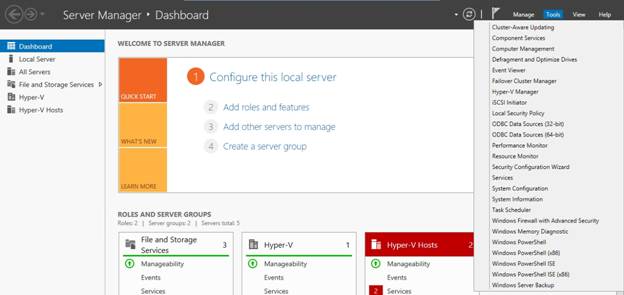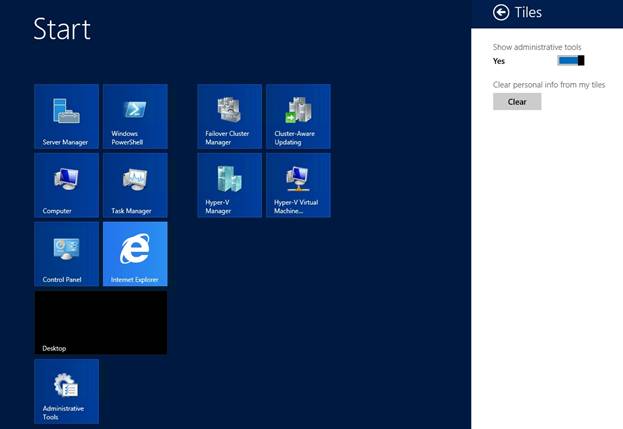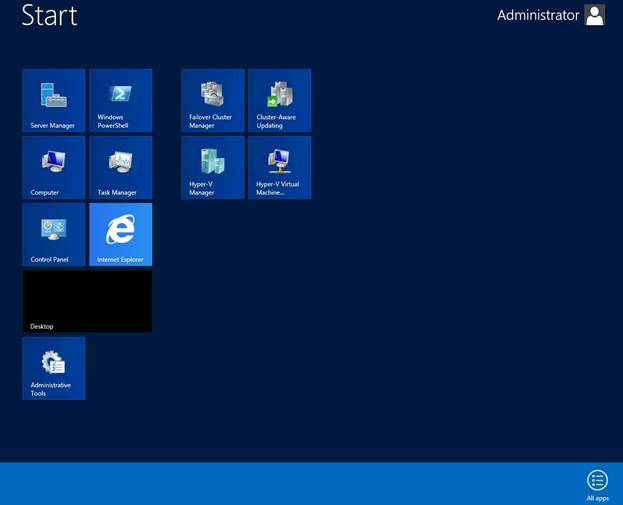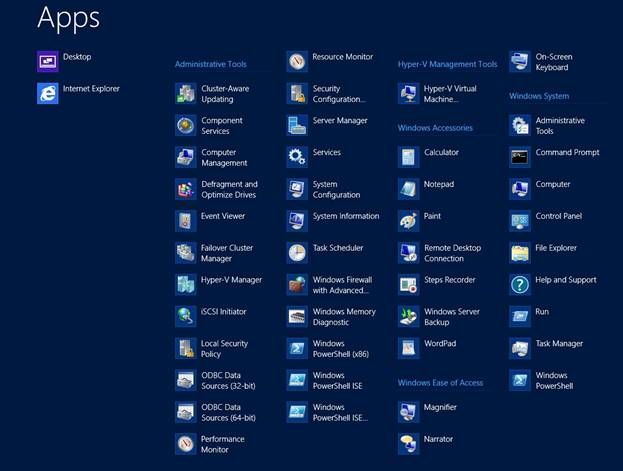Learn about Windows Server 2012 (Part 1)
Windows Server 2012 interface is easy to confuse users with previous versions like Windows Server 2008 or Windows Server 2008 R2.
In the article below, Network Administrator will guide you how to manage Task Manage on the new interface.
1. Introduction
On Windows Service 2012, the Metro interface and Server Manager have some changes.
And in fact, many Admin, users have difficulty implementing some basic commands because the new interface is completely different from the interfaces they used.
2. Restart the device
On Windows Service 2012, the Start Menu is no longer available. Meanwhile, if you want to turn off the computer, you must access the Start Menu.
To turn off or restart your computer, move your mouse over the top right corner of the screen. Windows will now display a series of icons on the right side of the screen. Click on the Settings icon (Settings) to display the Settings page (Settings).
Here you will see the Power button (power button). You can turn off or restart the computer by clicking on Button and selecting the option.

3. Access Control Panel
There are many ways to access Control Panel. Here are 2 ways to access the most popular Control Panel:
Method 1:
Move the mouse over the upper right corner of the screen. Windows will now display a series of icons on the right side of the screen. Click on the Settings icon (Settings). When the Settings page appears, click Control Panel.
Method 2:
Another way to access the Control Panel is on the Desktop, move the mouse pointer to the lower left corner of the screen. Tile Start will now appear on the screen. Your task is to right-click on tile Start, a new menu will appear. In this Menu contains the option to access Control Panel.
4. Access Administrative Tools
On Windows Server 2008 and Windows Service 2008 R2, you can access Administrative Tools by clicking the Start button, selecting All Programs, and then clicking Administrative Tools.
However, on Windows Server 2012 you can not do this as above because Start Menu on Windows Server 2012 is no longer available.
To access Administrative Tools on Windows Server 2012, you can use Server Manager:
You can see in the illustration below, Server Manager Tools menu contains the same Administrative Tools as on Windows Server 2008.

However, each time you want to access the Administrative Tools, you must access the Server Manager.
To access Administrative Tools more easily, you can set up access tools on Start Screen.
First on the Start Screen screen (not the Desktop), move the mouse to the upper right corner of the screen, click on the Settings icon (Settings).
When the Settings page appears, click on Tiles.
In the illustration below you see there is a slider. Does this slider use Administrative Control to display on Start Screens?

5. Access your applications (Apps)
One of the biggest drawbacks on the new interface makes users feel uncomfortable that all applications are not arranged on the Start Menu.
Some Admin found that after upgrading a previous version of Windows Server, the Start Screen contained only a small set of items that were previously on the Start Screen.
However the previous items on Start Screen do not disappear but remain on the computer. If you want to use it, you have to search for it on the machine.
To access all hidden Tile on the Start Screen, right-click any blank area on the Start Screen.
Then, a green bar will appear in the bottom corner of the screen as shown below.
You click on the All Apps icon that appears on the bar. The Application interface (Apps) will now appear on the screen. The applications are classified correctly as on the Start Menu.


6. Run Prompt and Command Line
In previous versions of Windows Server, you can use the Run prompt and Command Line easily and quickly.
For example, if you want to set up to access any utility like Management Console Disk, the easiest way is to open Run prompt and then enter the command DISKMGMT.MSC.
On Windows Server 2012 you can also access the Run prompt and Command Prompt easily. On the Desktop, move the mouse to the lower left corner of the screen. When Start Tile appears, right-click it. You will see a menu containing the Run, Command Prompt and Command Prompt (Admin) options.
You can refer to some articles below:
-
Small tips to help you master Windows Phone 8.1
-
4 Ways to Reset Windows to its original state
-
Backup and restore data on Windows Phone 8.1
Wishing you and your family a happy new year!
You should read it
- Learn about Windows Server 2012 (Part 2)
- How to install IIS in Windows Server 2012
- Instructions for installing Windows Server 2012 step by step
- Trick to start and shut down Windows Server 2012 computer in a blink of an eye
- Learn about firewalls, Windows Firewall on Windows Server 2012
- 6 ways to access Control Panel on Windows Server 2012
- Install Role, configure role on Windows Server 2012
- Learn about Easy Printing in Windows Server 2012
May be interested
- Test SQL Server with Windows PowerShell - Part 6
 part 6 will show you how to check all existing databases in the sql server instance and query the database properties.
part 6 will show you how to check all existing databases in the sql server instance and query the database properties. - Installing, configuring, and testing Exchange 2007 CCR on Mailbox Server (Part 2)
 in part 1 of this series, i talked about installing the windows 2003 cluster. the second part of this series will install the required windows components by exchange server 2007 as well as configure majority node set (mns) quorum with file share witness. finally, the activation and configuration of transmission on the hu server
in part 1 of this series, i talked about installing the windows 2003 cluster. the second part of this series will install the required windows components by exchange server 2007 as well as configure majority node set (mns) quorum with file share witness. finally, the activation and configuration of transmission on the hu server - Learn about the architecture of MS SQL Server
 in the previous articles, you already know briefly about sql server, how to install sql server on the computer. in this section we will learn about the architecture of sql server.
in the previous articles, you already know briefly about sql server, how to install sql server on the computer. in this section we will learn about the architecture of sql server. - 10 tips with PowerShell in Windows Server 2008 - Part 2
 in the previous article, i have shown you some of the basic functions and tricks that can be done with powershell in windows server 2008. and this time, we will continue with part 2, which is also the end. in powershell series in windows server environment ...
in the previous article, i have shown you some of the basic functions and tricks that can be done with powershell in windows server 2008. and this time, we will continue with part 2, which is also the end. in powershell series in windows server environment ... - Efficiently exploit printers in Windows Server 2003 (Part 2)
 in part 1 of this article, i have shown you how to configure single printers to manage managed printers on a server running windows server 2.
in part 1 of this article, i have shown you how to configure single printers to manage managed printers on a server running windows server 2. - Microsoft Windows PowerShell and SQL Server 2005 SMO - Part 9
 in part 9 of this series, i will show you how to use powershell in conjunction with smo to create a sql server script. creating sql server scripts is an important task for administrators and sql server database development professionals.
in part 9 of this series, i will show you how to use powershell in conjunction with smo to create a sql server script. creating sql server scripts is an important task for administrators and sql server database development professionals. - Microsoft Windows PowerShell and SQL Server 2005 SMO - Part 7
 each part of this series demonstrates how to use powershell in conjunction with smo to present sql server objects. part 7 of this series will demonstrate how to use powershell and smo to find all available objects in a database on the server.
each part of this series demonstrates how to use powershell in conjunction with smo to present sql server objects. part 7 of this series will demonstrate how to use powershell and smo to find all available objects in a database on the server. - Microsoft Windows PowerShell and SQL Server 2005 SMO - Part 5
 part i and part ii of this series showed you how to install powershell and simple smo and wmi cmdlets. in part iii, i showed you how to script powershell and connect to sql server. in part iv, i will show you how to use the powershell script to loop through the contents of the file and connect it
part i and part ii of this series showed you how to install powershell and simple smo and wmi cmdlets. in part iii, i showed you how to script powershell and connect to sql server. in part iv, i will show you how to use the powershell script to loop through the contents of the file and connect it - Network basics: Part 3 - DNS Server
 a dns server is a server that contains a database of public ip addresses and hostnames associated with them. in most cases, the dns server is used to resolve or translate those common names into ip addresses as required.
a dns server is a server that contains a database of public ip addresses and hostnames associated with them. in most cases, the dns server is used to resolve or translate those common names into ip addresses as required. - New update of Windows Server causes many serious errors
 recently, microsoft released updates kb5009555 for windows server 2012 r2, kb5009557 for windows server 2019, and kb5009555 for windows server 2022. these updates are part of the january 2022 patch tuesday updates.
recently, microsoft released updates kb5009555 for windows server 2012 r2, kb5009557 for windows server 2019, and kb5009555 for windows server 2022. these updates are part of the january 2022 patch tuesday updates.










 Learn about Windows Server 2012 (Part 2)
Learn about Windows Server 2012 (Part 2) Learn about Windows Server 2012 (Part 3)
Learn about Windows Server 2012 (Part 3) Learn Windows Server 2012 (The last part)
Learn Windows Server 2012 (The last part) Trick to start and shut down Windows Server 2012 computer in a blink of an eye
Trick to start and shut down Windows Server 2012 computer in a blink of an eye How to start Windows Server 2012 in Safe Mode
How to start Windows Server 2012 in Safe Mode 6 ways to access Control Panel on Windows Server 2012
6 ways to access Control Panel on Windows Server 2012